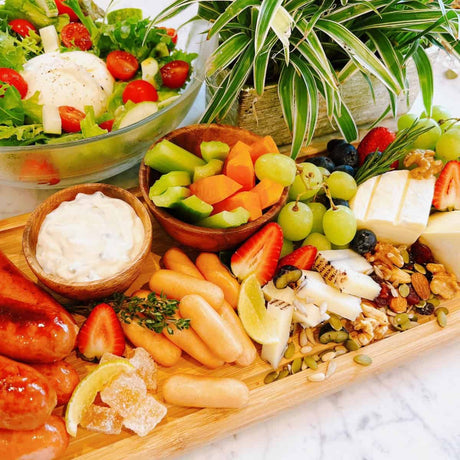- No products in the cart.
How much is a food serving?
09
Nov
Previously, I covered how to create a healthy meal plan around the 5 food groups and the importance of choosing a variety of foods within each group to maximise your nutrient intake. I want to look in this article at the actual food serving size to take and what that means to you in reality. There’s nothing more annoying than being told you need to have 2 servings of grains a day, yet not knowing how much that is in reality. To understand how many servings of food groups you should be eating per day, here’s a guide. Now let’s look at what makes up a single food serving in each group.
- Vegetables - 75g – usually ½ a cup
- Fruit – 150g – usually 1 medium fruit like an apple or 2 small ones like plums
- Grains – 500kj (portion sizes vary greatly from grain to grain)
- Meat, fish, eggs, nuts – 500-600KJ) portion sizes vary greatly from item to item
- Milk, yoghurt, cheese and alternatives – 500-600KJ) portion sizes vary greatly from item to item
How do I know how many kilojoules make a serving of each type of food?
Not all amounts of food have the same quantity of kilojoules per serving. For example, two servings of fruit, yet 5 servings of green leafy vegetables make up 500-600KJ. So you can understand here that you can eat more serving of leafy veg to get to 500KJ than you would fruit and that’s why eating green leafy veg is great for weight loss. Measure your food once It sounds like a chore to have to work out what size each serving of food should be as all foods are so different in size and texture. However, when you think about it, you only need to do this once and then keep a record to refer back to. After some time, you will instinctively know your food servings and be able to recognise when you are going over or under the daily recommended doses. Here's a guide on what makes one food serving that you can start with and you can always add on when you find food you want to include: Vegetables- ½ cup cooked green or orange vegetables (for example, broccoli, spinach, carrots or pumpkin)
- ½ cup cooked dried or canned beans, peas or lentils (preferably with no added salt)
- ½ cup sweet corn
- ½ medium potato or other starchy vegetables (sweet potato, taro or cassava)
- 1 medium tomato
- 1 cup green leafy or raw salad vegetable
- 1 medium apple, banana, orange or pear
- 2 small apricots, kiwi fruits or plums
- 1 cup diced or canned fruit (no added sugar)
- 1 slice (40g) bread
- ½ medium (40g) roll or flat bread
- ½ cup (75-120g) cooked rice, pasta, noodles, barley, buckwheat, semolina, polenta, bulgur or quinoa
- ½ cup (120g) cooked porridge
- ¼ cup (30g) muesli
- 1 (60g) crumpet
- 1 small (35g) English muffin or scone
- 65g cooked lean red meats such as beef, lamb, veal, pork, goat or kangaroo (about 90-100g raw)
- 80g cooked lean poultry
- 100g cooked fish fillet (
- 2 large (120g) eggs
- 1 cup (150g) cooked or canned legumes/beans such as lentils, chick peas or split peas (preferably with no added salt)
- 170g tofu
- 30g nuts, seeds, peanut or almond butter or tahini or other nut or seed paste (no added salt)
- ½ cup (120g) ricotta cheese
- ½ cup (120ml) evaporated milk
- ¾ cup (200g) yoghurt
- 1 cup (250ml) fresh, UHT long life, reconstituted powdered milk or buttermilk
- 1 cup (250ml) soy, rice or other cereal drink with at least 100mg of added calcium per 100ml
- 2 slices (40g) or 4 x 3 x 2cm cube (40g) of hard cheese, such as cheddar







